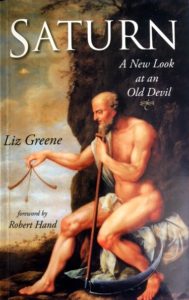The year is certainly hotting up, although not necessarily weather-wise – this is the UK after all. Well, meteorologically it is warmer and we are experiencing lovely light evenings – I can walk to way past nine now. Bird song and lush spring green. It is the period of the year when ‘winter can at last be banished’ and there are various pagan practices for doing so. Like ‘May Horns’ in Penzance where the blowing of horns is seen as one means of sending the last vestiges of winter away.
https://cornishculture.co.uk/portfolio/the-may-horns/
At the same time, there is always one eye on fertility. May 1st is Beltane after all and Green Man season. We are approaching the period of maximum pro-creativity, at least in the seasonal calendar – here, there are chicks and young horses in the forest. Central to all this is also ‘the Lord of Misrule’ who is a legendary character sent to stir things up in the belief that creativity happens best under not always ideal conditions – it needs something to kick against. Another Cornish custom is the ‘Obby Horse’ in Padstow that runs in and out of houses spreading mischief while folk dance and – well, get inebriated!!
Socio-politically there is much to say since things seem to be falling apart – I have never known such division in my life-time. The UK seems to be at civil war: we have a general election in the offing but I fear this will not resolve anything and for sure things are going to get a lot worst before they get better.
Culturally it was a supper active month for me. I went to the Opera – one of the few arts that I am not that enamored with. However, this was ‘popular’ and ‘classical’ opera in the form of Madame Butterfly by Puccini.
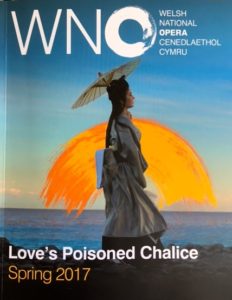
Of course, it is so well known that it has become almost clichéd. However, as all great art, its effects live on. So, I have seen it many times but still sat in rapt attention as the sad story unfolded: the original twixt, the consequences, the heartbreak of the ‘humming chorus’ where Butterfly waits for her now married ‘husband’ to come and he does not, and the final tragic ending. Cio-Cio San was sung by a brilliant young singer from Seoul, Karah Son. She certainly looked the part. When she takes the ‘honorable’ way out at the end – her paths of escape having closed one by one – there are thunderous orchestral chords as the now distraught Pinkerton cries ‘Butterfly’ three times as the terrible consequences of his actions become all too apparent. This left me in tears.
A good contrast, therefore, when my outing the next night took me to a local amateur dramatic society’s production of Abigail’s Party – a now famous play based around a small dinner party including a divorcee whose daughter – Abigail – is having her own party.
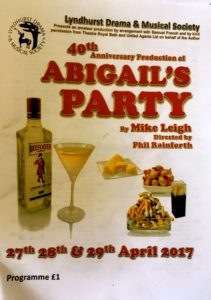
It was first broadcast by the BBC in 1977 on the night we had a huge hurricane in Britain. We woke up to trees across the roads and no electricity. The play came from the now famous director Mike Leigh who approaches work by getting his actors to improvise around a given situation/ scenario. This was has the excruciating Beverly at its core: voluptuous, gin swilling, with a taste for Demi Voussos and kitsch semi-erotic painting. Her long suffering husband is at her beck and call, as are the rest of her guests as she directs the evening. Lots of laughs about a certain culture and a certain time, but with a more thought provoking underside with respect to how we have built on these since!!
Lots of art also happening. One around paintings from the years after the Soviet Revolution; of course, by then art was meant to reflect the utopia of the new communist state. And so it did – with lots of asides on the reality. It makes one realize, again, how romantic the vision of a Marxist state is/ was. There seems little evidence, however, that we can bulk the wheels of capitalism for however long it lasts, and this exhibition is an important reminder about a – very large – country that tried.
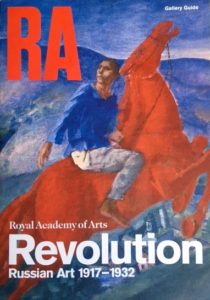
Speaking of capitalism , another art exhibition dealt with American art after the economic crisis in the 1930s.
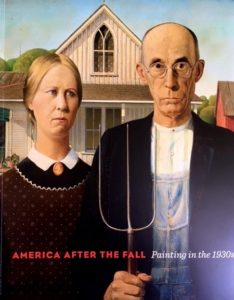
A particularly interesting period for me, since it covers a time just before American expressionism that I have looked at in some detail. One of the most famous paintings from the period I had previously seen in Chicago – and here it is in London; apparently almost one of the first times it has been allowed out of its home gallery.
Created in 1930, it depicts a farmer standing beside a woman that has been interpreted to be either his wife or his daughter. The figures were modeled by Wood’s sister, Nan Wood Graham, and Wood and Graham’s dentist, Dr. Byron McKeeby. The woman is dressed in a colonial print apron evoking 19th-century Americana, and the man is holding a pitchfork. The looks on their faces are meant to indicate the anxieties of the period and the hard work they undertook in order to survive. Edward Hopper’s ‘lonely’ city individuals are the other side of the coin: people lost in the urban crowds.
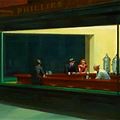
Howard Hodgkin – a famous English – has recently died and, as seems often to be the case, a major exhibition of his work was planned to open at around about the same time. This was is specifically ‘portraits’. I write portraits but most of these are not discernably so, and are overtly abstract.
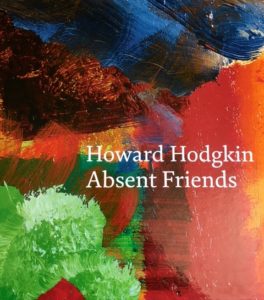
There were some early paintings and sketches to show how he could recall someone’s face almost perfectly from memory – good visual memory, then. But, most of the others were straight abstract. I have reacted against his work in the past, so I was curious to see what I would make of them this time. I found it was best when I just enjoyed the paintings for what they were – their colours and dynamism were truly engaging. However, when some sort of date and/ or name was given to them, I found it rather pretentious.
Then a real treat, and an invite to the ‘family and friends’ rehearsal of King Crimson in preparation for their forthcoming American tours. What can I say? Won’t give the game away but can certainly promise would-be concert goers that they are in for a real treat. Many pieces reworked and developed, other new additions – some real surprises. In fact, I was so knocked out by it, that I sort of wandered off post concert and missed the opportunity to speak to various ones. Well….
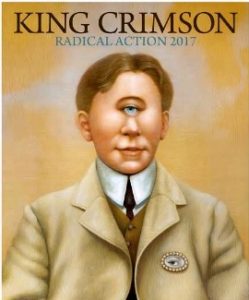
Two books of the month this month: One, on a man’s enquiry into that most famous of paintings – Las Meninas by Velázquez. The main author is Michael Jacobs but he died mid-project, so it was completed by his friend Ed Vulliamy. Of course, it is all about ‘gaze’ and perspective. Famously, it was discussed by Foucault at the beginning of his book The Order of Things. Lacan then critiques his account.
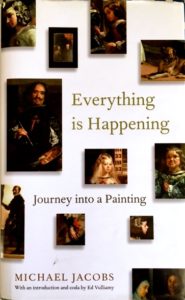
http://tombrockelman.com/2014/02/16/the-other-side-of-the-canvas-1/
The other book is about Saturn.
